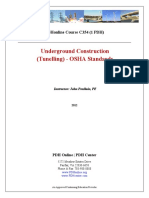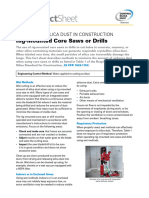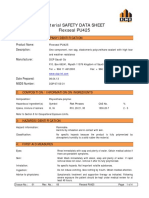OSHA3732
OSHA3732
Uploaded by
ZakirhasCopyright:
Available Formats
OSHA3732
OSHA3732
Uploaded by
ZakirhasOriginal Description:
Copyright
Available Formats
Share this document
Did you find this document useful?
Is this content inappropriate?
Copyright:
Available Formats
OSHA3732
OSHA3732
Uploaded by
ZakirhasCopyright:
Available Formats
Longshoring
in Marine
Fact Sheet Terminals
Safely Performing Hot Work on
Hollow or Enclosed Structures
OSHA requires employers to provide workplaces that are free of recognized hazards. Hot work
performed on hollow or enclosed structures in marine terminals can present hazards to marine terminal
workers. OSHA defines hot work to include riveting, welding, flame cutting, or similar fire- or spark-
producing operations. Requirements for hot work are in 29 CFR 1917.152.
Hollow or Enclosed Structures
Hollow or enclosed structures are objects on which marine terminal
employees work, but that are not large enough for them to enter.
These structures are not vented to the atmosphere and may be
filled with foam or preservatives to prevent corrosion. Hollow or
enclosed structures in marine terminals come in a variety of sizes
and shapes. Examples include, but are not limited to, drums,
inaccessible voids, pipe stanchions, booms, lampposts, crane
pedestals, crane-portal beams, doubler plates, railings, mooring
bitts and bollards, vents, and container frames. Requirements for
performing hot work on or in tanks or confined spaces, including
testing the atmosphere in confined spaces, are in 29 CFR 1917.152.
Explosion and Fire Hazards • Flammable material – This hazard can be created when
insulating foam or other commonly used materials catch fire
During hot work on hollow or enclosed structures, employers must and release noxious gases when exposed to an ignition source
take precautions to protect workers from exposure to a range of such as hot work.
hazards such as flammable or toxic gases, liquids, or residues;
combustible preservatives; saltwater; fuel oils; solvents, degreasers
Sources of Flammable or Explosive
or cleaning chemicals; and high-pressure or vacuum effects due to
fluctuating temperatures. However, employers must pay particular Atmospheres
attention to these known hazards: Flammable or explosive atmospheres in hollow or enclosed
structures can result from many sources, including:
• Explosive atmosphere – This hazard can be created when
there is a presence of flammable gases or dust in the air and an • Cargo containers may contain various types of chemicals. The
ignition source such as hot work is introduced. structure of the container or the container coating can absorb
chemicals and emit toxic gases.
• As a result, when a worker removes a stored product from, or
Note: States with OSHA-approved state plans may have different
cleans the container, the toxic gases in the container may create
requirements. See www.osha.gov.
a flammable or explosive atmosphere.
U.S. Department of Labor t www.osha.gov t (800) 321-OSHA (6742)
Control Measures Required for Hot Work on Hollow or Enclosed Structures
Prior to starting hot work operations, employers must:
• Have a designated person test the atmosphere in a hollow or enclosed structure to determine that the atmosphere is not
hazardous, 29 CFR 1917.152(c)(8)(i). [An NFPA-certified Marine Chemist may perform the tasks assigned to a designated person.]
• Ensure that suitable fire-extinguishing equipment is immediately available and ready for use at all times, 29 CFR 1917.152(c)(3).
• Train workers involved in hot work operations on the fire hazards of hot work and the use of firefighting equipment, 29 CFR
1917.152(c)(4).
• Ensure that workers wear proper personal protective equipment (PPE), clothing, gloves, and eye protection during hot work
operations, 29 CFR 1917, Subpart E.
• If normal fire-prevention precautions are not sufficient, assign additional personnel to guard against fires during hot work and for
a sufficient time after completing the work, 29 CFR 1917.152(c)(4).
• Make safe any hollow structure that previously contained flammable or combustible substances by cleaning the structure or filling
it with water and then ventilating the structure, 29 CFR 1917.152(c)(8)(i).
• Open the hollow structure to release pressure that builds up during heat application, 29 CFR 1917.152(c)(8)(ii).
• Rusting metals caused by oxidation can create an explosive • File a complaint asking OSHA to inspect their workplace if
atmosphere due to the release of hydrogen gas. they believe there is a serious hazard or that their employer
• Carbon monoxide gas released when welding on a hollow is not following OSHA’s rules. OSHA will keep all identities
or enclosed structure can accumulate to a high enough confidential.
concentration to become explosive. • Exercise their rights under the law without retaliation, including
• Flammable liquefied gas may leak from cargo containers, such reporting an injury or raising health and safety concerns with
as reefer units. If the flammable liquefied gas enters a hollow their employer or OSHA. If a worker has been retaliated against
or enclosed structure, an explosion can occur when an ignition for using their rights, they must file a complaint with OSHA as
source such as welding is present. soon as possible, but no later than 30 days.
For additional information, see OSHA’s Workers page.
Workers’ Rights
Workers have the right to: How to Contact OSHA
• Working conditions that do not pose a risk of serious harm. For questions or to get information or advice, to report an
• Receive information and training (in a language and vocabulary the emergency, fatality, inpatient hospitalization, amputation, or loss
worker understands) about workplace hazards, methods to prevent of an eye, or to file a confidential complaint, contact your nearest
them, and the OSHA standards that apply to their workplace. OSHA office, visit www.osha.gov or call OSHA at 1-800-321-
• Review records of work-related injuries and illnesses. OSHA (6742), TTY 1-877-889-5627.
This is one in a series of informational fact sheets highlighting OSHA programs, policies or standards. It does not impose any
new compliance requirements. For a comprehensive list of compliance requirements of OSHA standards or regulations, refer
DSG FS-3732 05/2014
to Title 29 of the Code of Federal Regulations. This information will be made available to sensory-impaired individuals upon
request. The voice phone is (202) 693-1999; teletypewriter (TTY) number: 1-877-889-5627.
U.S. Department of Labor t www.osha.gov t (800) 321-OSHA (6742)
You might also like
- Bulletproof Minding My Mithocondria Terry WahlsDocument20 pagesBulletproof Minding My Mithocondria Terry Wahlsesteban1yepes100% (3)
- Project No. 074-10 JHA No. 1Document20 pagesProject No. 074-10 JHA No. 1Adel SukerNo ratings yet
- CP 601S CP 601S: Elastomeric Firestop SealantDocument4 pagesCP 601S CP 601S: Elastomeric Firestop Sealantrichard_qrNo ratings yet
- Mcqs in Pharmaceutical Science and Technology Mcqs in Pharmaceutical Science and Technology (Paperback) (Paperback)Document3 pagesMcqs in Pharmaceutical Science and Technology Mcqs in Pharmaceutical Science and Technology (Paperback) (Paperback)Hely Patel0% (4)
- Unleash The Female BrainDocument16 pagesUnleash The Female BrainScribdnera100% (2)
- Oil and Gas Well Drilling and Servicing Etool - General Safety and Health - Hot Work - Occupational Safety and Health AdministrationDocument4 pagesOil and Gas Well Drilling and Servicing Etool - General Safety and Health - Hot Work - Occupational Safety and Health AdministrationIne Nurista100% (1)
- Cofined Space (Damilola Project)Document45 pagesCofined Space (Damilola Project)bright0175% (4)
- OSHA3787 Confined Spaces in ConstructionDocument2 pagesOSHA3787 Confined Spaces in ConstructionglenleafNo ratings yet
- Espaco Confinados FiocruzDocument12 pagesEspaco Confinados FiocruzVereador ExclusivoNo ratings yet
- Hot Work Hazard Alert - 09 28 16Document1 pageHot Work Hazard Alert - 09 28 16Ine NuristaNo ratings yet
- Safe Work in Confined SpacesDocument20 pagesSafe Work in Confined Spacesbathuka chuka100% (1)
- BTEC Assignment - Unit 23Document11 pagesBTEC Assignment - Unit 23Muthu Rajan100% (1)
- Trench Excavation FsDocument2 pagesTrench Excavation FsMUHAMMAD LUQMANNo ratings yet
- WSH Accident Advisory Worker Found With Upper Body in PipeDocument3 pagesWSH Accident Advisory Worker Found With Upper Body in PipekumarNo ratings yet
- Confined Space SafetyDocument5 pagesConfined Space SafetyMohamed GaafarNo ratings yet
- Fact Sheet: Hazards Associated With Spray Painting in Shipyard EmploymentDocument3 pagesFact Sheet: Hazards Associated With Spray Painting in Shipyard Employmentcarlo cuevas100% (1)
- Osha3788 PDFDocument2 pagesOsha3788 PDFoscarvega1029No ratings yet
- Toolbox Talks What Is A Confined Space?Document16 pagesToolbox Talks What Is A Confined Space?adeeb zahidNo ratings yet
- Hot Welding CuttingDocument19 pagesHot Welding Cuttingtheblues2708No ratings yet
- Sheet: Protecting Workers From Lead HazardsDocument2 pagesSheet: Protecting Workers From Lead HazardsMarcelo Gil SimõesNo ratings yet
- Risk Assesment in Confined SpaceDocument7 pagesRisk Assesment in Confined SpacePitchaiMohamed Mohamed IdrisNo ratings yet
- Safety Alert: Welding and Other Hot Work Procedures in Shipyard EmploymentDocument2 pagesSafety Alert: Welding and Other Hot Work Procedures in Shipyard EmploymentGenna Mae SantiagoNo ratings yet
- The Basics of Confined SpaceDocument17 pagesThe Basics of Confined SpaceRobVajko50% (2)
- Confined Space Training OutlineDocument28 pagesConfined Space Training OutlineCarrigan BillNo ratings yet
- Weekly Safety MeetingsDocument52 pagesWeekly Safety MeetingsparthaNo ratings yet
- Confined Space EntryDocument10 pagesConfined Space EntryPaolo MontesinesNo ratings yet
- Safe Work in Confined SpacesDocument21 pagesSafe Work in Confined Spacesdey6686No ratings yet
- Assignment OSHA July 2017Document4 pagesAssignment OSHA July 2017sarah sharilNo ratings yet
- Work Permit Conditions and Firewatch DutiesDocument40 pagesWork Permit Conditions and Firewatch DutiesClarissa Edwards75% (4)
- November New Letter 2012Document7 pagesNovember New Letter 2012Mohammed Jai Sujiya KhanNo ratings yet
- Safe Welding PracticesDocument10 pagesSafe Welding PracticesMark MianoNo ratings yet
- Fact Sheet Do You Know The Dangers of Hot Work Activities?: Case Study 1Document4 pagesFact Sheet Do You Know The Dangers of Hot Work Activities?: Case Study 1SBNo ratings yet
- BojalejeniraresovuveDocument2 pagesBojalejeniraresovuveShah MuzzamilNo ratings yet
- Guide To Dangerous Substances and Explosive Atmospheres RegulationsDocument16 pagesGuide To Dangerous Substances and Explosive Atmospheres RegulationsAndrew PeverillNo ratings yet
- OSHA3939Document2 pagesOSHA3939MITSS CANo ratings yet
- Confined Spaces: A Brief Guide To Working SafelyDocument7 pagesConfined Spaces: A Brief Guide To Working SafelyGanesh BaskerNo ratings yet
- OSHA 3103-Grain HandlingDocument24 pagesOSHA 3103-Grain Handlingseguridadyambiente641No ratings yet
- Cs Explovent GuideDocument16 pagesCs Explovent GuideErica LindseyNo ratings yet
- JuukoDocument3 pagesJuukopxwqrwwy6zNo ratings yet
- Gasunie Confined Spaces 052015Document9 pagesGasunie Confined Spaces 052015technologiewaterNo ratings yet
- Essay FGCDocument5 pagesEssay FGCBianca SandovalNo ratings yet
- Confined Space EntryDocument14 pagesConfined Space EntryCarmel Ares Luzano100% (1)
- Confined Space PermitDocument1 pageConfined Space PermitMalcolm DiamondNo ratings yet
- Confined Space SafetyDocument30 pagesConfined Space SafetyJerome GarganeraNo ratings yet
- Sheet: Internal Combustion Engines As Ignition SourcesDocument5 pagesSheet: Internal Combustion Engines As Ignition SourcesBolivar PozoNo ratings yet
- HotworkDocument8 pagesHotworknghiemxuangiang1986No ratings yet
- OSHA3286 - Using Portable Generators Safely - Uso Seguro de Generadores PortátilesDocument2 pagesOSHA3286 - Using Portable Generators Safely - Uso Seguro de Generadores PortátilesRaúlNo ratings yet
- ManualDocument13 pagesManualkenoly123No ratings yet
- Hot Work ProceduresDocument4 pagesHot Work ProceduresMuhammad Sajid Shams100% (1)
- What Are The Dangers From Confined Spaces?Document3 pagesWhat Are The Dangers From Confined Spaces?Richard MurielNo ratings yet
- Cms-2 Detector de MonoxidoDocument17 pagesCms-2 Detector de MonoxidoJORGEALEXERNo ratings yet
- S3-HSE Rules For ContractorsDocument30 pagesS3-HSE Rules For ContractorsIcaro Icaro IcaroNo ratings yet
- DSEAR GuideanceDocument8 pagesDSEAR GuideancePAUL LessiterNo ratings yet
- NIOSH Confined Spaces 1986 PDFDocument22 pagesNIOSH Confined Spaces 1986 PDFBruno ThiemeNo ratings yet
- Underground Construction TunellingDocument31 pagesUnderground Construction TunellingVibhanshu MishraNo ratings yet
- OSHA3929Document2 pagesOSHA3929Herminio Román MoralesNo ratings yet
- OSHA 10+ GuideDocument56 pagesOSHA 10+ GuideAnsarNo ratings yet
- Confined Spaces in The WorkplaceDocument13 pagesConfined Spaces in The WorkplacechedinthrashNo ratings yet
- Introduction to Petroleum Process SafetyFrom EverandIntroduction to Petroleum Process SafetyRating: 3 out of 5 stars3/5 (2)
- Dust Explosion and Fire Prevention Handbook: A Guide to Good Industry PracticesFrom EverandDust Explosion and Fire Prevention Handbook: A Guide to Good Industry PracticesNo ratings yet
- Osh Induction Program in Enhancing Safety Awareness Amongst Fabrication Workers in Brooke Dockyard, Kuching, SarawakFrom EverandOsh Induction Program in Enhancing Safety Awareness Amongst Fabrication Workers in Brooke Dockyard, Kuching, SarawakRating: 5 out of 5 stars5/5 (1)
- Workplace Vocabulary for Esl Students: With Exercises and TestsFrom EverandWorkplace Vocabulary for Esl Students: With Exercises and TestsNo ratings yet
- Daily Spill Kit Insp. ChecklistDocument1 pageDaily Spill Kit Insp. ChecklistZakirhasNo ratings yet
- Shahind IndiaDocument3 pagesShahind IndiaZakirhasNo ratings yet
- Flexseal PU425 - 3Document4 pagesFlexseal PU425 - 3ZakirhasNo ratings yet
- DustDocument1 pageDustZakirhasNo ratings yet
- Emergency Response SBREFA Fact Sheet 8-21Document1 pageEmergency Response SBREFA Fact Sheet 8-21ZakirhasNo ratings yet
- 4 Hour Heat Stress Training Student Manual 508Document42 pages4 Hour Heat Stress Training Student Manual 508ZakirhasNo ratings yet
- Hot Work Safety ProgramDocument11 pagesHot Work Safety ProgramZakirhasNo ratings yet
- Developing An Emergency Response Plan 2Document7 pagesDeveloping An Emergency Response Plan 2ZakirhasNo ratings yet
- 106 Toolbox Talks e BookDocument181 pages106 Toolbox Talks e BookZakirhas100% (1)
- Tool Box Talks Unsafe TrenchesDocument2 pagesTool Box Talks Unsafe TrenchesZakirhasNo ratings yet
- Health Awareness (Ent - Ear Nose Throat, Musculoskeletal & Dermatological) English & ChineseDocument5 pagesHealth Awareness (Ent - Ear Nose Throat, Musculoskeletal & Dermatological) English & ChineseZakirhasNo ratings yet
- Excavating ADocument2 pagesExcavating AZakirhasNo ratings yet
- Fy15 Sh-27664-Sh5 Toolbox Angle GrinderDocument2 pagesFy15 Sh-27664-Sh5 Toolbox Angle GrinderZakirhasNo ratings yet
- Update On COVID-19 Projections: Science Advisory and Modelling Consensus Tables September 28, 2021Document19 pagesUpdate On COVID-19 Projections: Science Advisory and Modelling Consensus Tables September 28, 2021Braydon WilliamsonNo ratings yet
- Project Officer - Services Linkages-1 Position: Base: TBC (Pha-an/Phapon/Taunggoo) VA: 2021-HI-011Document4 pagesProject Officer - Services Linkages-1 Position: Base: TBC (Pha-an/Phapon/Taunggoo) VA: 2021-HI-011saw thomasNo ratings yet
- First-Time Taker Pass Rates - Maintenance of Certification - American Board of Internal MedicineDocument1 pageFirst-Time Taker Pass Rates - Maintenance of Certification - American Board of Internal MedicineabimorgNo ratings yet
- Contraceptionppt 1Document22 pagesContraceptionppt 1Basma TaherNo ratings yet
- Final Msds Hand SanitizerDocument4 pagesFinal Msds Hand SanitizerAngga Putra MargaNo ratings yet
- Wan Nurafifah Binti Wan Mohammad Nadzim - hs245 4cDocument10 pagesWan Nurafifah Binti Wan Mohammad Nadzim - hs245 4cMOHD MU'IZZ BIN MOHD SHUKRINo ratings yet
- Aptis General - Aptis SV - Reading TestDocument7 pagesAptis General - Aptis SV - Reading TestChu Thi Ngoc Quynh QP1057No ratings yet
- Community Support Program: D Management S, B U, L CDocument7 pagesCommunity Support Program: D Management S, B U, L CAnum ManzoorNo ratings yet
- Communicable Disease Practice TestDocument8 pagesCommunicable Disease Practice Testrenee_torres100% (1)
- CRB Whitepaper Vapor Hydrogen Peroxide Decontamination WebDocument8 pagesCRB Whitepaper Vapor Hydrogen Peroxide Decontamination WebVictor LeiNo ratings yet
- Sex EducationDocument3 pagesSex EducationJ. VierezNo ratings yet
- Gagan's Resume 1Document2 pagesGagan's Resume 1Praveen MalhhotraNo ratings yet
- My Project: Match The Phrases With The Pictures That Best Represent Them. Follow The ExampleDocument5 pagesMy Project: Match The Phrases With The Pictures That Best Represent Them. Follow The ExampleKATIA YULIANA HUAMAN HUAMANNo ratings yet
- Biomedical Signal Processing and Control: Iftikhar Ahmad, Faysal Munir, Muhammad Faizan MunirDocument8 pagesBiomedical Signal Processing and Control: Iftikhar Ahmad, Faysal Munir, Muhammad Faizan MunirBrasoveanu GheorghitaNo ratings yet
- Analisis Implikasi Gagasan Omnibus Law Kesehatan Sebagai Dasar Kebijakan Layanan Telemedisin Di IndonesiaDocument12 pagesAnalisis Implikasi Gagasan Omnibus Law Kesehatan Sebagai Dasar Kebijakan Layanan Telemedisin Di Indonesiazahwa dnNo ratings yet
- FORMULA RANSUM Ayam Broiler Standar (GROWER) : Nama Bahan BK EM Protein Lemak SK (%) (Kkal/kg) (%) (%) (%)Document5 pagesFORMULA RANSUM Ayam Broiler Standar (GROWER) : Nama Bahan BK EM Protein Lemak SK (%) (Kkal/kg) (%) (%) (%)Irma Rahayu NingrumNo ratings yet
- 5 Ways You Can Reduce Your Trading AnxietyDocument3 pages5 Ways You Can Reduce Your Trading AnxietySamuel AnemeNo ratings yet
- Your Cleaning Schedule: Safe MethodDocument2 pagesYour Cleaning Schedule: Safe MethodAlghubariNo ratings yet
- HCE-scp Week 3 - WorksheetDocument3 pagesHCE-scp Week 3 - WorksheetLeah Mariz RocaNo ratings yet
- PTS Handbook 2020 Issue 10Document84 pagesPTS Handbook 2020 Issue 10yebidid232No ratings yet
- Acute Renal Failure/Akut Kidney InjuryDocument10 pagesAcute Renal Failure/Akut Kidney InjuryYanti TandjungNo ratings yet
- Quality of Life: Meditations On People and ArchitectureDocument6 pagesQuality of Life: Meditations On People and ArchitectureRaj GuptaNo ratings yet
- 62ab4779c788134e8bbcf066 - Six Healing SoundsDocument3 pages62ab4779c788134e8bbcf066 - Six Healing Soundstamhid nahianNo ratings yet
- CV RamniwasDocument2 pagesCV RamniwasGouthamNo ratings yet
- LEGAL EXPLANATION LETTER OF HUMAN RIGHTS - Coercing Face Mask and Vaccination in IndiaDocument6 pagesLEGAL EXPLANATION LETTER OF HUMAN RIGHTS - Coercing Face Mask and Vaccination in IndiaBasil Mabrook VNo ratings yet
- Rapid River: Operators ManualDocument82 pagesRapid River: Operators ManualASHLEY011266No ratings yet
- OET Sample Reading Test NewDocument22 pagesOET Sample Reading Test NewAHMED TANJIMUL ISLAM100% (3)






































































































